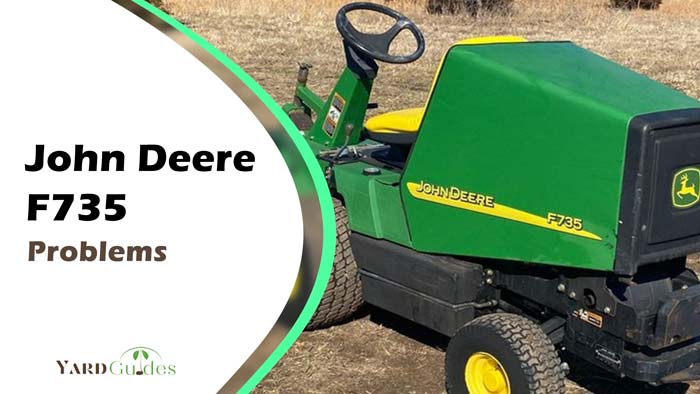The John Deere F735 mower is a commercial front-mount mower designed for heavy-duty use. While it is generally a reliable machine, a few common problems can arise with this model.
So, what are the most observed John Deere F735 problems? Common problems range from engine issues, such as cycling and stalling, to blades not engaging. In some instances, the mower won’t start or keeps going off. Also, most users report that the deck keeps coming off.
We’ll be looking at the 6 most common issues with the John Deere F735 and how you can fix them. So, let’s dive in!
The John Deere F735 Problems & Solutions Chart
Before getting into the in-depth discussion, Take a look at the common problems and their possible solutions below. These will help you to get an overall insight into the issues.
Check the following for in-depth discussions of the issues, and get their possible solutions.
| Problems | Solutions |
| 1. Engine issues | 1. Clean/replace the plug and fix loose or broken wires (if the engine cycles down) 2. Run the second cylinder (for stalling engine) |
| 2. Blade issues (Engine cuts off when blades are engaged) | 1. Clear blade obstructions 2. Replace bad clutch bearing 3. Reconnect or tape the loose fittings in the mower’s seat safety feature |
| 3. Blowout issues | 1. Adjust the deck pitch 2. Use the right cutting blades |
| 4. Deck keeps coming off | 1. Tighten the deck belt or check deck pitch (For loose deck belt) 2. Replace deck belt (if damaged) 3. Align and tighten the blades (if improperly aligned) |
| 5. Mower won’t start | 1. Check fuel level and refill 2. Drain tank and replace with fresh fuel (if contaminated or old) 3. Clear fuel lines of clogs or leaks 4. Loosen the fuel cap 5. Replace cam gear (if broken) |
| 6. Mower keeps going off | 1. Loosen fuel cap or unplug vent hose (in case of vapor lock) 2. Change the fuel filter and clear the fuel line of clogs 3. Keep the interface clean |
1. Engine Issues
Engine cycling down or stalling is one of the most common problems that plague the F735 mowers. It often happens when cutting longer grass, especially in the wet season.
Electrical issues, ignition system problems, air intake problems, and fuel system issues are to blame for the engine stalling and cycling down.
Solutions:
- Replace the spark plug or the air filter if dirty. Also, ensure that there’s enough gas in the fuel tank and that the fuel line is free of clogs. If that fails to solve the issue, examine and repair any frayed or broken wire connections.
- Run on the other cylinder in case of stalling issues. After all, the F735 front mower has a 2-cylinder engine.
2. Blade issues (Engine cuts off when blades are engaged)
Sometimes, the engine dies once you engage the blades. People may mistake it for lack of engine power. However, the problem is not with the engine.
The first likely cause is blade obstructions. Cords or ropes left on the lawn can become tangled in the blade, causing it to stop spinning. Similarly, pebbles or other small rocks can get caught in the blade, causing the blade to become stuck.
Also, it may be a malfunctioning seat safety switch. The seat switch has contact sets that engage the blades, one of which links to the engine. Due to its vulnerability to corrosion, breaking, and bending, the seat switch can fail to complete the necessary circuit for the engine to run.
In addition, when the mower blade is engaged, the clutch bearings are put under additional stress and load. If one of these bearings is already damaged or worn, it may not be able to handle this additional stress and could fail, causing the engine to shut down.
Solutions:
- Replace the clutch bearing if the clutch pulley doesn’t turn freely
- Fix loose fittings in the seat safety switch
- Identify and remove blade obstructions
3. Blowout Issues
You might notice your mower spewing out debris in all directions from under the mowing deck. Possible causes for the blow-out could be defective blades, cutting height that is too high, or an incorrect deck pitch.
Solutions:
Keep your mower on a level pavement and measure the distance between the pavement and the blade tips. First, measure the distance between the pavement and the front tip. Afterward, measure the clearance between the pavement and the back tip.
You want to ensure that the front of the deck is slightly lower than the back, in the order of 1/8 to 1/4 inches. Here’s a video for adjusting the mower deck pitch.
Also, use the right cutting blades. You may want to avoid double-blade combos as they’re more prone to causing blowout issues.
4. Deck Keeps Coming Off
There are several reasons a mower deck keeps coming off. Here are a few common reasons:
- Loose or worn deck belt: The deck belt on your mower is responsible for driving the blades. If the belt is loose or worn, it can cause the blades to stop turning or become unstable, which can lead to the deck coming off.
- Unstable blades: If one or more of the blades on your mower is unstable, it can cause the deck to shake or vibrate, which can ultimately cause it to come off.
Solutions:
- Ensure the cutting blades are properly aligned for even weight distribution
- Tighten the deck belt to torque specifications
- Replace worn-out deck belt
5. Mower Won’t Start
The common reason why your F735 mower won’t start is that it is not getting gas. This could be due to several factors, such as a clogged fuel filter, a bad fuel pump, a faulty carburetor, or a blocked fuel line.
Also, it could be that there isn’t enough fuel in the tank. In addition, the problem may be contaminated or incorrect fuel.
Another reason a mower might not start is a clogged vent in the fuel cap. This can create a vacuum in the gas tank, preventing fuel from flowing to the engine.
A broken cam gear is another potential cause. The cam gear, also known as the camshaft sprocket, is responsible for driving the camshaft, which controls the opening and closing of the engine’s valves.
If the cam gear is broken, it can cause the camshaft to stop turning, which will prevent the engine from running. This is because the valves cannot open and close correctly, preventing fuel and air from entering the engine and exhaust gases from leaving it.
Solutions:
- To troubleshoot fuel-related issues, ensure the fuel level is appropriate and refill it if needed. Additionally, empty the tank and fill it with new fuel of the correct type.
Furthermore, ensure the fuel lines are free of clogs or leaks. Additionally, consider loosening the fuel cap or performing a carb rebuild if that fails.
- Check the fuel pump. If it goes bad, replace it with a new one.
- Replace bad cam gear. To protect against potential failure, we suggest using steel cam gear rather than plastic. Furthermore, swapping out the oil and water pump gear is advisable.
6. Mower Keeps Going Off
One of the most common reasons a lawnmower keeps going off is vapor locking. This occurs when the fuel in the carburetor evaporates, causing a blockage in the fuel line and preventing the fuel from reaching the engine.
A clogged or blocked fuel line can also cause the engine to keep going off. This can happen due to dirt, debris, or rust buildup. Dirt or debris buildup on the interface between the carburetor and the engine can also be the cause.
Solutions:
- To fix the vapor locking issue, wait for the engine to cool, check the fuel cap for proper venting, and check the fuel line for kinks or damage.
Loosening the fuel cap and unplugging the vent hose will often solve the problem. Also, a study by ACS Publications shows that using fuel with higher oxygenates improves vapor lock protection.
- Disconnect the fuel line, clean it, and reconnect it. If the fuel line is severely damaged, it may need to be replaced.
- Consider replacing the fuel filter. Always perform filter change after every 200 hours or annually for the F735.
- Remove the carburetor and clean the interface thoroughly before reinstalling it.
Conclusion
Though reliable, John Deere F735 is not immune to problems. The most common complaints owners encounter include engine malfunction, failure to start, shutting off unexpectedly, failure to engage blades, blowout problems, and disconnection of the deck.
Preventative maintenance is key in maintaining the optimal condition of your mower; this involves routine cleaning and servicing. Additionally, it’s important to stick to the maintenance plan outlined in the owner’s manual for the best results.



